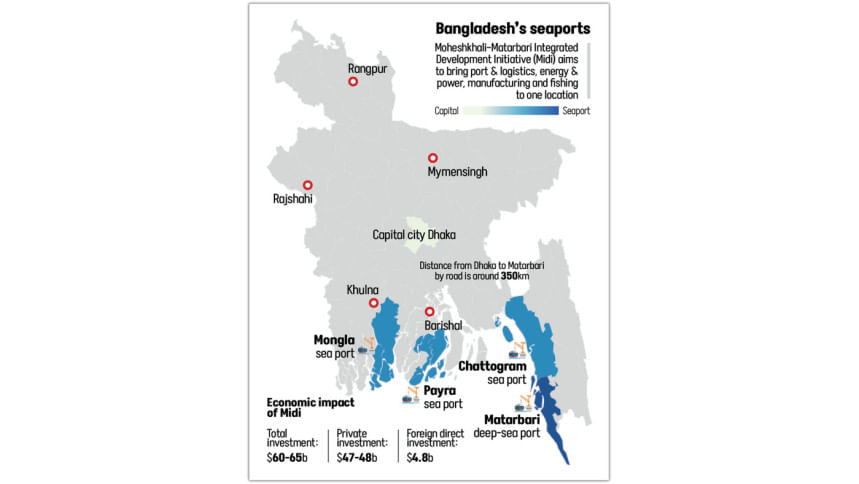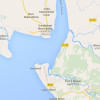Govt eyes 1.5 lakh jobs from Moheshkhali industrial hub

The government has unveiled an ambitious plan to reshape the coastal economy by turning Moheshkhali island into the country's next industrial and logistics hub.
Over the next 30 years, the project is expected to create 1.5 lakh direct jobs and add $150 billion directly to the GDP.
The Moheshkhali-Matarbari Integrated Development Initiative (Midi), a flagship state-backed project, will lead the transformation of the island, an upazila under the southeastern district of Cox's Bazar.
The initiative is backed by $60 billion in projected investment, including targeted foreign direct investment.
Ashik Chowdhury, executive chairman of Maheshkhali Integrated Development Authority (Mida), yesterday presented a four-month action plan to Chief Adviser Professor Muhammad Yunus at the state guest house Jamuna. He outlined a three-phase roadmap running from 2025 to 2055.
"Mida is not just about a port or a power plant, it is a new economy being built from the coastline inward," Chowdhury told reporters.
He said, "We want to see the Matarbari-Moheshkhali as a township. The world calls Singapore one of the most successful deep-sea port townships, and another port that often comes up is Shanghai."
At the heart of the plan is the Matarbari deep-sea port, designed with a natural depth of 18.5 metres to allow large cargo ships to dock directly without feeder vessels.
Referring to Matarbari, he said, "Imagine if we wanted to build a Singapore in Bangladesh, or a Shanghai port inside Bangladesh. After 30 years, we want to see the Maheshkhali-Matarbari area as something like Singapore or Shanghai."
"This will not be a town for vessels, nor a satellite town. It will be a suburb, another extended port of Chattogram, but one that is reformed and new in nature."
Matarbari deep-sea port is expected to handle a quarter of the country's bulk cargo and nearly half of its container traffic, increasing the country's overall port capacity by 50 percent in the next three decades.
The port will act like the anchor for a wider economic zone, bringing together four sectors.
According to Chowdhury, those sectors are logistics, manufacturing, energy and marine resources. He said that they were identified for their potential to create jobs and attract long-term investment.
The location of Moheshkhali near international shipping routes, combined with its distance from urban congestion and access to deep waters, makes it a strategic site for large-scale development, according to Mida's strategic report.
A study by the Japan International Cooperation Agency (Jica) estimated that the Moheshkhali-Matarbari region could attract $60 billion to $65 billion in investment over 20 to 30 years, including nearly $5 billion in FDI. It projected a direct GDP impact of up to $75 billion, with the overall contribution reaching $150 billion, according to the report.
Mida expects to create about 1.5 lakh direct jobs and up to 25 lakh when indirect employment is included, spanning sectors such as infrastructure, port operations, manufacturing, logistics, fisheries, food processing, housing, transport, retail and healthcare.
As the port expands, jobs will also be created in customs, warehousing, shipbuilding and transport. Planned rail and highway links connecting Moheshkhali to Dhaka are expected to generate demand for thousands of trained and semi-skilled workers across the supply chain, says the Mida report.
It also says better connectivity is projected to help Moheshkhali emerge as a major manufacturing hub, contributing nearly 10 percent of national industrial output by 2055.
Priority sectors include steel and heavy engineering, agro and food processing, automobiles and auto parts, electronics and semiconductors, pharmaceuticals, synthetic fibres and garments, and shipbuilding and repair.
The initiative is also expected to save $6 billion annually on the balance of payments by cutting imports through domestic production.
To meet rising energy demand, which is growing at about 6.7 percent a year, Mida plans to set up a power and fuel import hub featuring LNG and LPG terminals. These could supply up to 80 percent and 60 percent of national demand, respectively. A proposed petroleum refinery would meet around 35 percent of the country's needs.
Together, these facilities are projected to save $3.4 billion in logistics costs while creating jobs in operations, fuel handling, maintenance, construction, safety and environmental services.
In the marine sector, Bangladesh currently uses only a fraction of its Indian Ocean tuna quota.
With the Matarbari port enabling quicker seafood exports to the European Union, USA and Japan, and with approval of 28 new longliner vessels, the region is expected to capture a much larger share.
The scallop industry alone is projected to generate $500 million in exports. A strong cold-chain and seafood processing network could create thousands of jobs, especially for women and small-scale entrepreneurs.
To build a skilled workforce, Mida plans to set up training centres focused on marine trades, logistics, automation and industrial maintenance.
Supporting infrastructure such as housing, schools, hospitals, and vocational institutes will also be developed to make Moheshkhali both an industrial hub and a liveable community.
The plan further includes eco-tourism parks, conservation zones and green corridors to preserve the island's natural environment while creating sustainable jobs in tourism and conservation.
Tourism in Cox's Bazar is expected to grow by 1.5 times as new facilities are built, generating more employment in hospitality, food services, transport and tour guiding.
Mida's 120-day work plan is already underway, with the full masterplan scheduled for completion by the end of 2025.

 For all latest news, follow The Daily Star's Google News channel.
For all latest news, follow The Daily Star's Google News channel. 








Comments